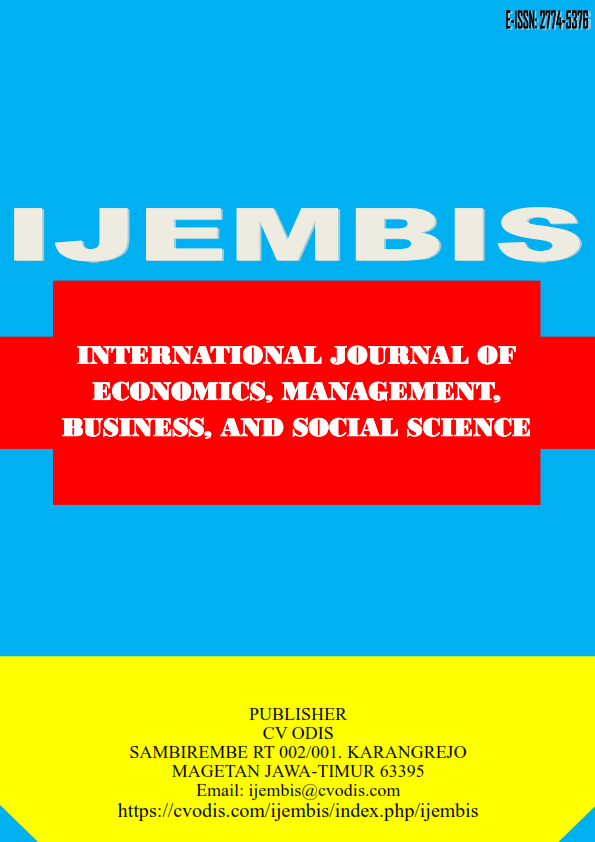The Impact Factors of Customer Satisfaction and Customer Loyalty on BNI London Branch
DOI:
https://doi.org/10.59889/ijembis.v1i1.8Keywords:
Service Quality, Product Quality, Customer Trust, Customer Satisfaction, Customer LoyaltyAbstract
The purpose of this study was to analyze the factors that build customer satisfaction to increase BNI bank's customer loyalty at the London branch. the factors studied were service quality, product quality, and customer trust. the statistical method for analyzing data is the structural equation model (SEM) from the Smart-PLS 2.M3 statistical package. The results of the study indicate that directly the service quality, product quality has an effect, and customer trust has an effect on customer satisfaction. Direct service quality, product quality, and customer trust do not affect customer loyalty. whereas indirectly through customer satisfaction, product quality, and customer trust affect customer loyalty. Customer loyalty is formed from the trust that was created previously in the minds of customers. customer loyalty to a product, will not move to other banks to invest money so that both parties benefit. Customer loyalty is a key factor in banking success. Customer Trust Dominant factors that influence Customer Loyalty, increasing customer trust makes customers more loyal to BNI London branch by keeping promises that have been said, prioritizing customer interests, and updating knowledge of the products they have. By understanding various aspects related to the formation of trust under customer expectations and increasing customer confidence will increase customer loyalty in the future.
Downloads
References
Arikunto, S. (2012). Prosedur Penelitian Suatu Pendekatan Praktek. Jakarta: Rineka Cipta.
Ariyani, F. (2008). “Membangun Customers Loyalty Melalui Peningkatan Kualitas Pelayanan Dan Keunggulan Produk (Studi Empiris Pada PT. Bank Bukopin Tbk di Kota Semarang)”. Tesis. Semarang: Program Pascasarjana Universitas Diponegoro. Retrieved from https://docplayer.info/30127940-Membangun-loyalitas-nasabah-melalui-peningkatan-kualitas-pelayanan-dan-keunggulan-produk-studi-empiris-pada-pt-bank-bukopin-tbk-di-kota-semarang.html.
Assauri, S. (2007). Manajemen Pemasaran. Jakarta: Rajawali Pers.
Bei, L.-T. a.-C. (2001). An Integrated Model for the Effects of Perceived Product, Perceived Service Quality, and Perceived Price Fairness on Consumer Satisfaction and Loyalty. Journal of Consumer Satisfaction, Dissatisfaction, and Complaining Behavior, 14(1), 57-78. Retrieved from http://jcsdcb.com/index.php/JCSDCB/article/view/110
Creswell, J. W. (2008). Educational Research: Planning, Conducting And Evaluating Quantitative and Qualitative Research. New Jersey: Pearson Education Inc.
Endarwita. (2013). Pengaruh Quality of Product dan Kualitas Pelayanan Terhadap Kepuasan dan Loyalias Nasabah Tabungan BRI Cabang Simpang Empat. e-Jurnal Apresiasi Ekonomi, Vol. 1 No. 3, 167-180.
Flavian, & Giunaliu. (2007). Measure on web usability Website. Journal of Computer Information Systems, 48(1), 17-23.
Hair, J., Anderson, R., Tatham, R., & Black, W. (1998). Multivariate Data Analysis. Upper Saddle River: Prentice Hall International Inc.
Hair, J., Black, W., Babin, B., Anderson, R., & Tatham, R. L. (2006). MultivariatData Analysis (Sixth ed.). New Jersey: Pearson Prentice Hall.
Hidayat, R. (2009, Maret). “Pengaruh Kualitas Layanan, Quality of Product dan Nilai Nasabah Terhadap Kepuasan dan Customers Loyalty Bank Mandiri”. Jurnal Manajemen Dan Kewirausahaan, Vol.11, No. 1, 59-72. Retrieved from http://jurnalmanajemen.petra.ac.id/index.php/man/article/view/17746
Holm, M. G. (2000). Service quality and product quality in housing refurbishment. International Journal of Quality & Reliability Management, 17(4/5), 527-540. doi:10.1108/02656710010298562.
Ikhsan, A., & Ishak, M. (2005). Akuntansi Keperilakuan. Jakarta: Salemba Empat.
Jayachandran, S., Hewett, K., & Kufman, P. (2004). Customer Response Capability in Sense and Respond Era: The Role of Customer Knowledge Process. Journal of The Academy of Marketing Science, 32, 219-233.
Lupiyoadi, & Hamdani. (2008). Manajemen Pemasaran Jasa (2 ed.). Jakarta: Salemba Empat.
Lupiyoadi, R. (2001). Manajemen Pemasaran Jasa (Teori dan Praktek) (1st ed.). Depok: Penerbit Salemba Empat.
Prasetyo, W. B. (2013). “Pengaruh Kualitas Pelayanan, Kepercayaan dan Kepuasan Terhadap Loyalitas Pelanggan (Studi Pada Swalayan Luwes Purwodadi)”. Tesis. Purwodadi: Universitas Dian Nuswantoro.
Ridwan, H., Pusporini, & Samin. (2018). Pengaruh Kepercayaan, Kualitas Pelayanan, Dan Nilai Nasabah Terhadap Loyalitas Pelanggan Melalui Kepuasan Sebagai Variabel Intervening Pada Bank BNI. Pengabdian Kepada Masyarakat Melalui Diseminasi Hasil Penelitian Terapan (hal. 140-146). Lampung: Fakultas Ekonomi dan Bisnis Universitas Lampung.
Simamora, E. R. (2007). “Analisis Faktor-Faktor Yang Membangun Customers Satisfaction Untuk Meningkatkan Loyalitas Pelanggan”. Tesis. Semarang: Program Pascasarjana Universitas Diponegoro.
Simamora, H. (2000). Manajemen Pemasaran Internasional. Jakarta: Salemba Empat.
Sofyan, M. (2019). Analysis Financial Performance of Rural Banks in Indonesia. International Journal of Economics, Business and Accounting Research (IJEBAR), 3(3), 255-262. doi:10.29040/ijebar.v3i03.588
Sofyan, M. (2019). Faktor-Faktor Yang Mempengaruhi Profitabilitas Bank Perkreditan Rakyat (BPR) di Provinsi Jawa Timur. Jurnal Inspirasi Bisnis Dan Manajemen, 3(1), 63-76. doi:10.33603/jibm.v3i1.2093
Somantri, A., & Muhidin, S. A. (2006). Aplikasi Statistika Dalam Penelitian. Bandung: Pustaka Setia.
Supriyadi, Edy. (2014). SPSS+AMOS. Bogor: IN MEDIA.
Supriyanto, E. (2003, Maret). Memaksimalkan Keuntungan dengan Customers Loyalty. InfoBank.
Tjiptono, F., & Chandra, G. (2005). Service, Quality, & Satisfaction. Yogyakarta: Penerbit ANDI.
Umar, H. (2008). Metode Penelitian Untuk Skripsi dan Tesis Bisnis. Jakarta: PT. Rajagrafindo Persada.
Wijanto, S. H. (2008). Structural Equation Modeling. Yogyakarta: Graha Ilmu.
Wiryono, S. K., & Diahmarrisa, T. (2003). Analisis Kualitas Pelayanan Jasa Penerbangan, Studi Kasus : Garuda Indonesia kelas Ekonomi. Jurnal Manajemen Teknologi, 2(10), 13-23. Retrieved from http://journal.sbm.itb.ac.id/index.php/mantek/article/view/18/9
Downloads
Published
How to Cite
Issue
Section
License
Copyright (c) 2021 INTERNATIONAL JOURNAL OF ECONOMICS, MANAGEMENT, BUSINESS, AND SOCIAL SCIENCE

This work is licensed under a Creative Commons Attribution-NonCommercial-ShareAlike 4.0 International License.









